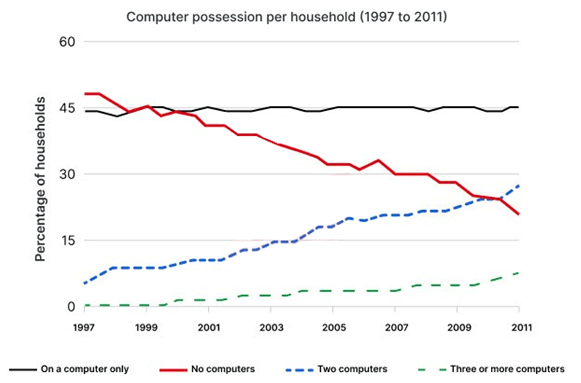5+ The graph below gives information about computer possession by households in one European country
The graph below gives information about computer possession by households in one European country between 1997 and 2011. Summarise the information by selecting and reporting the main features, and make comparisons where relevant. Write at least 150 words hay nhất giúp bạn có thêm tài liệu tham khảo để viết bài luận bằng Tiếng Anh hay hơn.
- The graph below gives information about computer possession by households in one European country (mẫu 1)
- The graph below gives information about computer possession by households in one European country (mẫu 2)
- The graph below gives information about computer possession by households in one European country (mẫu 3)
- The graph below gives information about computer possession by households in one European country (mẫu 4)
- The graph below gives information about computer possession by households in one European country (mẫu 5)
- The graph below gives information about computer possession by households in one European country (mẫu 6)
- The graph below gives information about computer possession by households in one European country (mẫu 7)
5+ The graph below gives information about computer possession by households in one European country
Đề bài: The graph below gives information about computer possession by households in one European country between 1997 and 2011. Summarise the information by selecting and reporting the main features, and make comparisons where relevant. Write at least 150 words
The graph below gives information about computer possession by households in one European country - mẫu 1
The line graph shows computer ownership statistics per household in a particular European country from 1997 to 2011. Overall, single-computer households were most common for the majority of the period. Meanwhile, there was a distinct downward trend in the percentage of households without any computers, contrasted by corresponding rises in households possessing two or more computers.
During the period shown, the rate of families owning only one computer hovered around the 45% mark, remaining the highest from 1999 onwards.
Meanwhile, households without a computer showed a marked decrease. In 1997, they constituted around 60% of the population, but by 2011, their figure had more than halved.
In contrast, around 7% of households possessed two computers at the beginning of the timeframe, after which the figure grew considerably, overtaking that of those without a computer in 2010 and ending at nearly 30%. While starting from nearly zero in the first few years, households with three or more computers saw a similar, albeit slower increase, reaching roughly 8% in the final year.
The graph below gives information about computer possession by households in one European country - mẫu 2
The given graph illustrates the percentage of families with computers in Europe from 1997 to 2011.
From a glance, it can be seen that it was less likely for a household not to have a computer than it was at the beginning of the period. Moreover, it had been highly common for each of them to have a computing device.
In 1997, about half of the European population did not have a computer at home. This figure steadily fell to just under a third in 2006 (30%) before experiencing a minimal recovery to 35% in the next year. It continued to gradually decline and hit its lowest point of 20% in 2011. Meanwhile, the percentage of households with only one computer remained relatively unchanged at 45% throughout the period.
In contrast, the portion of European families with two or three computers underwent an upward trend. At the beginning. 5% of them had two devices. The data doubled the next year, followed by a period of stability which lasted till 2000. It surged to 25% within five years and after that, soared to 30% in 2011. Similarly, the percentage of households with three computers, which was not presented in the 1990s, slowly rose to 5% in 2005. There was a moderate growth of another 5% in this figure during the final years.
The graph below gives information about computer possession by households in one European country - mẫu 3
The line chart illustrates computer possession per household in a European nation from 1997 to 2011.
It is evident that computer ownership notably ascended during this period. The majority of households had only one computer, while a modest percentage possessed three or more.
In 1997, the highest proportion of households, approximately 47%, did not own a computer, but this sharply declined to around 20% by the end of the period. Conversely, households with just one computer commenced at approximately 43% in 1997, remained relatively stable throughout the years, and concluded at 45% by 2011. This category consistently represented the largest share of computer ownership over the 1999-2011 time frame.
Regarding two-computer ownership, the figure was significantly lower, amounting to 7% in 1997, and gradually progressed, overtaking the percentage of households with no computers around 2010, to culminate in approximately 30% in 2011. Concurrently, ownership of three or more computers began at a mere 1% in 1997 and also saw a modest rise, reaching around 8% by the conclusion of the period. Despite the increase, the possession of three or more computers remained relatively rare in this nation.
The graph below gives information about computer possession by households in one European country - mẫu 4
The line chart provides statistics regarding computer ownership from families in a nation in Europe, from 1997 to 2011. Overall, the proportion of households who possessed at least one computer increased, whereas that of families that did not own a computer showed a reverse trend. Additionally, the rate of three or more computer owners was constantly the lowest.
Regarding the categories that started with the highest, the share of households that did not have a computer in 1997 was approximately half then dropped significantly to 30% in 2007, before it finished at roughly 20%. The proportion of families that owned only one computer started at approximately 43% and witnessed minimal fluctuations over the period, before finishing at 45% in the end.
Concerning the remaining categories, around 7% of households possessed two computers in 1997. The figure then ascended gradually and ended at nearly 30%, after overtaking that of no computer owners sometime around 2010. Finally, in 1997, it was rare for a family in this nation to possess three computers; nevertheless, by 2011, this proportion had moderately risen to approximately 8%.
The graph below gives information about computer possession by households in one European country - mẫu 5
The provided illustration depicts how the ownership of computers per family in a European country changed from 1997 to 2011.
Overall, despite experiencing fluctuations at different levels, there were upward trends in the percentages of households owning a single computer, two computers, and three or more computers, but a downward trend in the proportion of households without this electronic device.
Commencing with computer ownership per household in 1997, one striking feature is that almost no families had three or more devices. The highest percentage was among households without any, at over 46%, followed by households with a computer and those with two, at just under 45% and approximately 5%, respectively.
A following observation reveals that the percentage of families with a solitary computer exhibited subtle fluctuations, concluding the period at precisely 45%, emerging as the predominant category among the four. In contrast, households with two computers and three or more, following a consistent pattern throughout the given timeframe, gradually rose to around 25% and 5%, respectively. Notably, only in two years between 2009 and 2011, did the former surpass the number of families without computers, becoming the second most prevalent group in the survey. Conversely, the figures for households without any computers saw a significant decline of about a third over the 14-year span, claiming its position as the third most ubiquitous category.
The graph below gives information about computer possession by households in one European country - mẫu 6
The line graph shows changing trends in computer ownership in an unspecified country in Europe from 1997 to 2011. Overall, computer ownership increased significantly during this period and there was an increasing trend for households to have more than one computer. In addition, one-computer possession was generally the dominant category throughout.
At the beginning of this period, in 1991, computer ownership was uncommon in this country in Europe, with slightly under 45% of the population having one computer only and just over 5% of households owning two computers. However, the situation changed quite rapidly over the next 6 years and by 2003, the percentage of households without computers had dropped significantly, falling from around 50% to 35%, while roughly 15% had two computers.
Over the next 8 years, from 2003 to 2011, single-computer families remained relatively stable at around 45%. In contrast, the percentage of households who did not possess a computer continued to fall, albeit slightly more sharply.
This continued decline corresponded with increases in the ownership of multiple computers, with owning two computers rising to marginally below 30% in 2011, while three or more computers accounted for close to 10%. Notably, households having two computers increased to a greater degree than three or more computers during this period, and the trend for three or more did not begin until the early 2000s.
The graph below gives information about computer possession by households in one European country - mẫu 7
The given chart illustrates the changes in computer ownership among households in a European country from 1997 to 2011.
Overall, a shift from a significant lack of ownership in 1997 to a landscape in 2011 where a substantial portion of households owned not just one, but multiple computers. Also evident is that households with a single computer retained the majority share despite the growing prevalence of dual or more devices.
At the start of the period in 1997, nearly half of families did not own any computer. Meanwhile, approximately 45% of households had one computer, a figure nearly quadrupling the percentage of those with two computers. There was a mere 2% of families having three or more computers.
Thereafter, computer-less households exhibited a consistent downward trajectory, ending at approximately 20% in 2011. In stark contrast, the ownership of two computers and three or more computers followed an ascending trend. Notably, the former witnessed a dramatic upswing, peaking at almost 30% in 2011, while the latter experienced a more modest growth, reaching around 10% in the same year. Finally, a relatively stable pattern can be seen in the figure for households with just one computer, hovering around 45% throughout the entire period.
Xem thêm các bài luận Tiếng Anh hay khác:
Đã có app VietJack trên điện thoại, giải bài tập SGK, SBT Soạn văn, Văn mẫu, Thi online, Bài giảng....miễn phí. Tải ngay ứng dụng trên Android và iOS.
Theo dõi chúng tôi miễn phí trên mạng xã hội facebook và youtube:Nếu thấy hay, hãy động viên và chia sẻ nhé! Các bình luận không phù hợp với nội quy bình luận trang web sẽ bị cấm bình luận vĩnh viễn.
- Đề thi lớp 1 (các môn học)
- Đề thi lớp 2 (các môn học)
- Đề thi lớp 3 (các môn học)
- Đề thi lớp 4 (các môn học)
- Đề thi lớp 5 (các môn học)
- Đề thi lớp 6 (các môn học)
- Đề thi lớp 7 (các môn học)
- Đề thi lớp 8 (các môn học)
- Đề thi lớp 9 (các môn học)
- Đề thi lớp 10 (các môn học)
- Đề thi lớp 11 (các môn học)
- Đề thi lớp 12 (các môn học)
- Giáo án lớp 1 (các môn học)
- Giáo án lớp 2 (các môn học)
- Giáo án lớp 3 (các môn học)
- Giáo án lớp 4 (các môn học)
- Giáo án lớp 5 (các môn học)
- Giáo án lớp 6 (các môn học)
- Giáo án lớp 7 (các môn học)
- Giáo án lớp 8 (các môn học)
- Giáo án lớp 9 (các môn học)
- Giáo án lớp 10 (các môn học)
- Giáo án lớp 11 (các môn học)
- Giáo án lớp 12 (các môn học)






 Giải bài tập SGK & SBT
Giải bài tập SGK & SBT
 Tài liệu giáo viên
Tài liệu giáo viên
 Sách
Sách
 Khóa học
Khóa học
 Thi online
Thi online
 Hỏi đáp
Hỏi đáp

